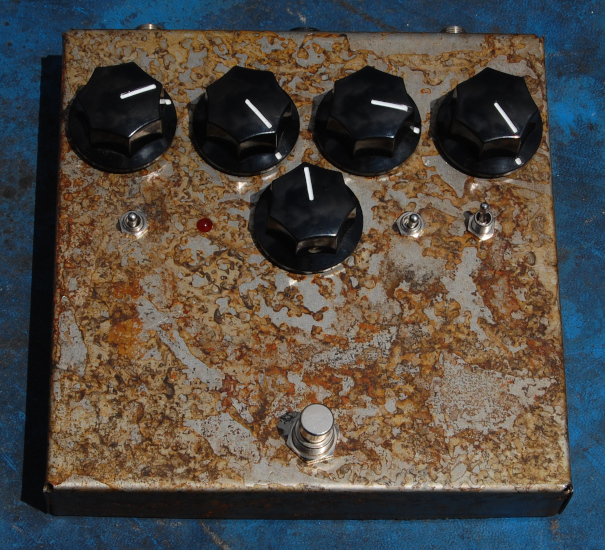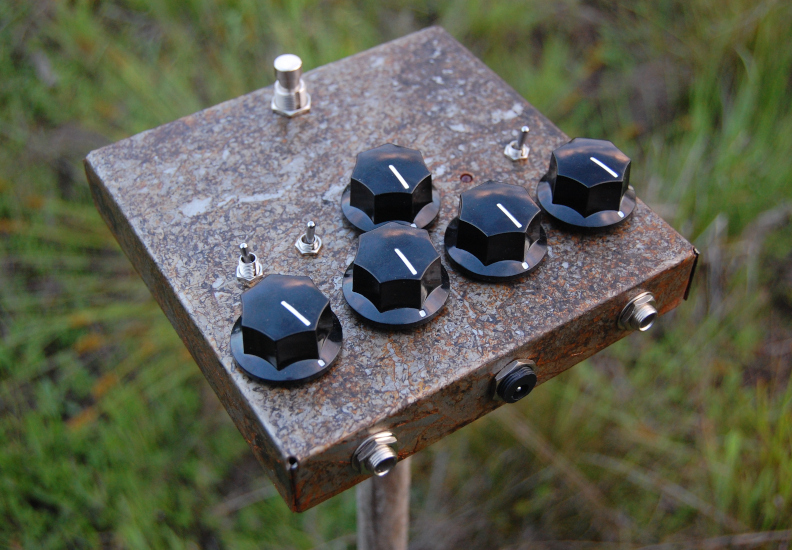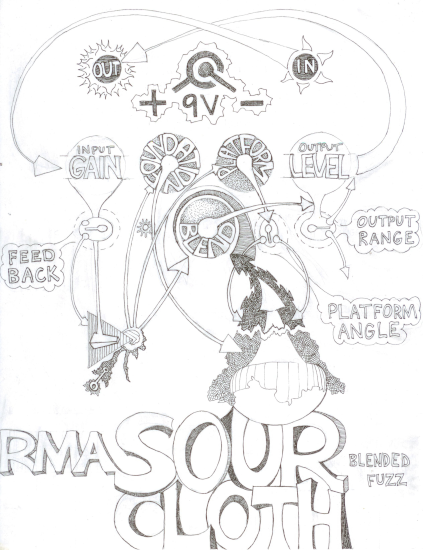Sour Cloth
Sour Cloth is built into a 6x6x1 inch, or (roughly) 16x16x3 hand bent enclosure of mild steel, that is generally force fed a patina that results in patterns of rust. Baseplate is typically friction fit and may be unsuitable for use with velcro on a pedalboard without installation of screws in the sidewall. Please let me know if such screws are preferred, as I generally leave them off for aesthetic reasons.
Sour Cloth is essentially two functional stages interwoven into a delightful mess that can range from a mildly articulated bloom to a putrid squeeze of sound. The following descriptors are presented in reference to the location of the controls.
- Upper left knob defines input gain. This stage is an operational amplifier based circuit that remains relatively clean (depending on input signal level) until control rotation reaches roughly 2-3 o'clock, after which signal integrity degrades with vigor. This signal feeds the remainings stages, and will be referred to as the "clean" signal, even when it's not.
- Center left knob of the upper row defines amount of clean signal that is fed into the "lower level" of the fuzz stage, which basically amounts to an analog multiplier built with discrete transistors. In the parlance of a synthesizer VCA, this is controlling the CV level through which further amplification occurs. Due to the unbalanced nature of this analog multiplier, signal will still be present at the output of the fuzz stage even if the associated control is fully dumped, or turned counter-clockwise, so long as the next control is employed.
- Center right knob of the upper row defines the amount of signal that is fed into the "upper level" of the fuzz stage, which, due to the proximity to the stage output imparts a generally toppier flavor of sound with respect to the control to its left.
- Upper right knob is an output volume control, we all know what those do.
- Leftmost switch on the lower row actuates feedback. With the bat "down" the instrument input is compared to electrical common/ground while the input gain stage does its work. With the feedback bat "up", ground reference is lifted a little bit across a resistor and the input is compared to the output, which is also now acting like an input establishing a state of feedback. This feedback tends to coalesce into "motorboating" as opposed to a high pitch squeal, and its musical usefulness is not entirely understood.
- The LED at inner left should illuminate when the effect is engaged and remain dark in bypass.
- The center knob is a blend control, with the (post gain) clean signal feeding the counter-clockwise end of rotation, and the fuzz feeding the clockwise end of rotation. Please note that extreme gain settings at input will blast all the stages to such a degree that blend becomes considerably less effective.
- Switch at inner right selects which "side" of the upper fuzz tier sees signal. It amounts to a polarity selector for that stage only, but the result can be rather subtle in comparison to what someone may think inverting signal within a fuzz cell SHOULD sound like, so maybe think of that as a mild voicing selector.
- Rightmost switch is output level range, with bat "up" being high (think line & synth level) and bat "down" being low (think instrument level)
This design requires a 9 volt negative tip power supply. Please note, there is an on-board SMPS producing internal voltages of a biplor nature straddling ground, and feeding voltages other than 9 volts can disrupt operational characteristics or cause damage. Save your over-volting for circuits that don't already have 18 volts to play with.
DEVICE
Sour Cloth
TYPE
Dirt Circuit
STATUS
Current
PRICE
$250 USD plus shipping



